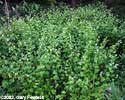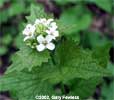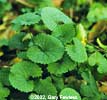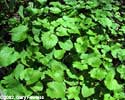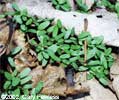
Invasive Plants of Wisconsin
|
Alliaria petiolata is an herbaceous, biennial plant with white four-petaled flowers and long, linear fruits. The seeds germinate early in the spring and the seedlings soon produce numerous blunt leaves which only extend a few inches above the ground level. In dense populations the first-year leaves may block virtually all sunlight from reaching the ground, thereby interfering with any other plants growing in the area. The leaves store energy in the large roots, and both the leaves and roots overwinter, the leaves remaining green throughout. In the second year the plants develop a vertical stem up to 3 or 4 feet tall with the familiar blunt, petiolate leaves at its base and smaller, more pointed and nearly sessile leaves towards its top. The plants begin to flower in May and quickly produce the long linear fruits, each of which splits open at maturity to release numerous small, blackish seeds. Several other species of plants may look roughly similar, but only Alliaria will smell like garlic if a fresh leaf is crushed. Alliaria is one of the most threatening of invasive plants because it can thrive in our natural woodlands and essentially eliminate our native wild flowers. The spring wildflowers of deciduous forests are almost symbolic of Wisconsin's wild places and few if any are immune to the spread of Garlic mustard. Forests on more acid soils seem to be less suitable for good growth of Alliaria and basic soils are more favorable. Alliaria is very difficult to control once it has become well established on a site. The best method of control is to prevent colonization to begin with. Prioritize sites to be protected, monitor all sites annually and remove new colonists as soon as possible. Since the plants do not produce seeds in the first year, there is a full year (from the spring they germinate through the following spring) to find the invaders before they can produce seeds to expand the population. The first-year leaves remain green and are often highly visible in Fall and intoWinter until they are covered with snow, and again after the snow melts in the spring, providing a long period for detection. For sites already infested with Alliaria, a great deal of effort is required to reclaim the area. It is best to resist the first urge to grab a tool and wade into the middle of the worst patch you can find. Such sites can scarcely get worse, and remember that people are one of the primary sources for carrying the seeds to new sites, so you may do more harm than good if you spread the plant to new areas via seeds on your shoes and clothes. A better plan is to survey the area and begin working to eliminate the outlying, young colonies first and then work your way in toward the heavier density areas. If the plants have been on any site long enough to produce seeds, you may have to repeat the removal of plants each year for 5-10 years or more. And of course the potential exists for new colonizations in the future, so Garlic Mustard monitoring will be a permanent necessity.
|
|
